
9 minute read
CALIDOSCOPIO
FIESTA DEL FUEGO
LA GRAN CELEBRACIÓN DEL CARIBE
EN SANTIAGO DE CUBA
Santiago celebró, por todo lo alto, la 41 edición del Festival del Caribe. Del 3 al 9 de julio, la tierra caliente se convirtió en epicentro de festejo, ritmo, tradición, academia, comunidad y arte, en torno a la cultura caribeña y las profundas raíces que hermanan a los pueblos de la región. Luego de dos años en modalidad virtual, la Fiesta del Fuego retornó a los espacios presenciales, dedicada este 2022 al cuadragésimo aniversario de la fundación de la Casa del Caribe. Celebró además los 40 años de la agrupación sonera Septeto Turquino y los 30 del grupo teatro estudio Macubá. Desde el Salón Principal del emblemático Teatro Heredia, se dio inicio a esta gran fiesta con una especial gala de homenajes y buen arte, reflejado en las presentaciones de Macubá, Las Voluminosas del Caribe, el Ballet Folklórico Oriente, el Septeto Turquino, la Compañía All Stars y la centenaria Tumba Francesa “La Caridad de Oriente”. El arte, en todas sus manifestaciones, y la investigación, confluyeron durante estos días para celebrar el Caribe, su riqueza cultural e historia.
The great celebration of the Caribbean in Santiago de Cuba
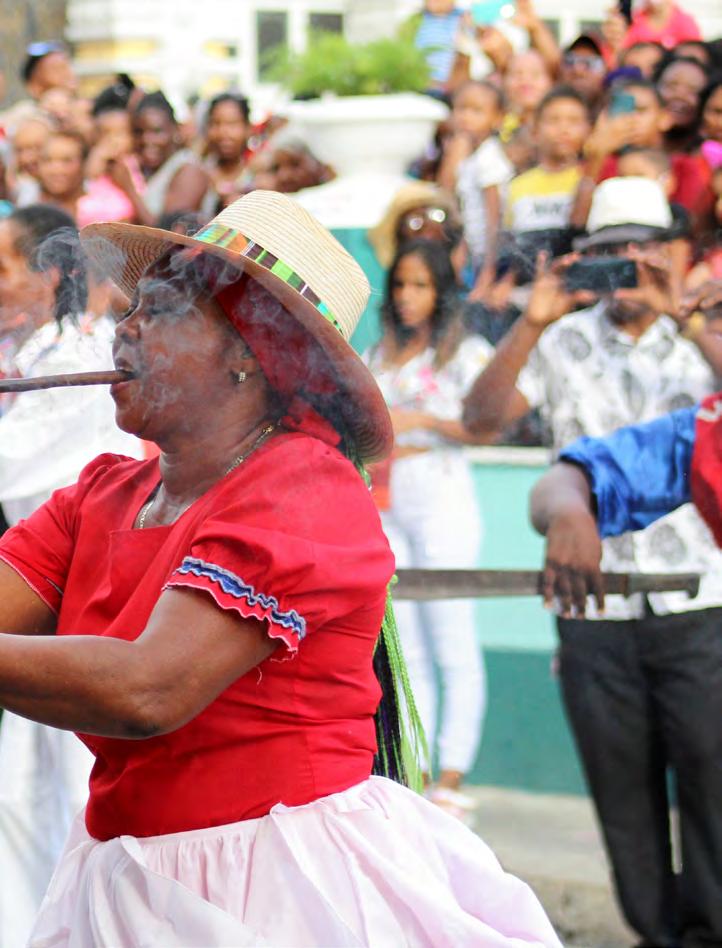
Santiago celebrated, in style, the 41st edition of the Caribbean Festival. From July 3 to 9, the city became the center of celebration, rhythm, tradition, academy, community and art around the Caribbean culture and these deep roots that unite the peoples of the region. After two years online, the Fiesta del Fuego came back to on-site spaces, dedicated this 2022 to the 40th anniversary of the founding of the Casa del Caribe. It also celebrated the 40th anniversary of the son group Septeto Turquino and the 30th anniversary of the theater group Macubá. From the Main Hall of the emblematic Heredia Theater, this great celebration began with a special ceremony of homages and good art, displayed in the performances of Macubá, Las Voluminosas del Caribe, Ballet Folklorico Oriente, Septeto Turquino, Compañía All Stars and Tumba Francesa “La Caridad de Oriente”. Art in all its expressions and research came together during these days to celebrate the Caribbean, its cultural richness and history.
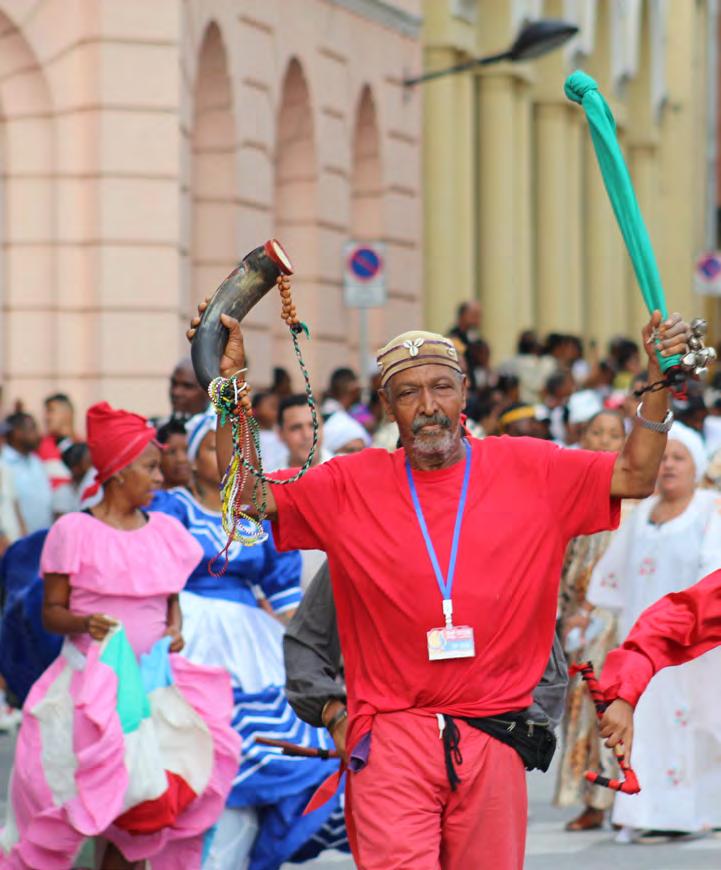
Las artes visuales cautivaron con la más hermosa expresión de la identidad caribeña y la participación de artistas cubanos y extranjeros. Resaltaron, en este sentido, las muestras colectivas “Vivencias” y “Nostra Terra”, el tercer Salón de Pintura Naif, la exposición “Evocación al trópico” y “Mágica Ciudad”, de fotografía. Asimismo, la filmografía de la región tuvo su espacio con las muestras del Taller de Cine del Caribe, con sede en el Cine Rialto. Por su parte, el Taller de Oralidad del Caribe fue punto de encuentro entre narradores orales, decimistas, cuenteros y repentistas, mientras que el Taller de Estudios Literarios del Caribe acogió diversas presentaciones de libros, paneles, exposiciones bibliográficas y homenajes a escritores. Si de bailes y sonoridades se trata, destacó el Taller de Danza y Percusión Cubana y del Caribe, en el que se realizaron sesiones de aprendizaje y prácticas llenas de ritmo y sabor, desde la Alianza Francesa de esta urbe suroriental. Sobresalió la diversidad de estas sesiones de aprendizaje, muestra de ello fueron las conferencias y exhibiciones en el Encuentro Internacional de Tatuaje y Perforación y el taller de Confección de máscaras, impartido por el teatrista y académico Lowell Fiet. Como el festival lleno de ritmos que representa, la música alegre y estremecedora llegó a cada rincón de la ciudad. No faltaron los buenos conciertos y la arrolladora conga santiaguera, con su identitaria corneta china, atrayendo, agrupando, poniendo a todos a bailar. Un amplísimo y variado programa académico distinguió la jornada. Como cada año, el Coloquio “El Caribe que nos une” fue escenario de conferencias y diálogos enriquecedores, con la participación de importantes investigadores del área. La cultura popular de estos pueblos, su desarrollo artístico y social fueron tópicos durante los debates.
The visual arts captivated with the most beautiful expression of the Caribbean identity and the participation of Cuban and foreign artists. In that regard, collective exhibitions “Vivencias” and "Nostra Terra", the third exhibition of Naif Painting, the exhibition “Evocación al trópico” and “Mágica Ciudad” of photography are highlighted. Movies of the region also had its space with the screening of the Taller de Cine del Caribe, held at the Rialto Movie Theater. Taller Oralidad del Caribe was a meeting point for oral narrators, decimistas, storytellers and improvisers, while Taller de Estudios Literarios del Caribe hosted various book launch events, panels, book exhibitions and tributes to writers. As for dance and music, Taller de Danza y Percusión Cubana y del Caribe was highlighted, with learning and practice sessions full of rhythm and flavor, from the Alliance Française of Santiago de Cuba. The diversity of these learning meetings stands out, as evidenced by the lectures and exhibitions at the International Tattoo and Piercing Meeting and the mask-making workshop given by theater scholar Lowell Fiet. The joyful and thrilling music reached every corner of the city, representing the festival full of rhythms. There was no shortage of good concerts and the overwhelming Santiago conga with its distinctive Chinese horn, attracting, grouping people, putting everyone to dance. A very broad and enriching academic program distinguished these days. As every year, the Colloquium “El Caribe que nos une” was the scene of enriching conferences and discussions with the participation of important researchers in the area. The popular culture of these peoples, their artistic and social development were topics during the discussions.
El I Taller Internacional de industrias culturales y creativas propició el intercambio sobre temáticas como la planeación de estrategias y políticas para la creación artística y cultural, que contribuyan a una ciudad más integradora y sostenible. Sesionó también el Taller de Educadores Populares, en el que pedagogos de distintas enseñanzas se dieron cita para dialogar sobre la educación cubana y del Caribe. Además, desde la Universidad de Oriente, el Taller de Arqueología del Caribe estuvo integrado por mesas de trabajo, presentaciones de catálogos arqueológicos y paneles, constituyendo un importante aporte al rescate de la historia de estos pueblos. El Taller de Religiosidad Popular congregó a estudiosos en torno a temas como el espiritismo, la Regla de Palo Monte, Vodú, Ocha-Ifá, y la religiosidad popular desde el canto, la percusión y la danza folclórica. Se desarrollaron así, fructíferas ponencias, presentaciones de libros y exposiciones de proyectos en el Salón de los Grandes de la Casa de la Trova, en Santiago.
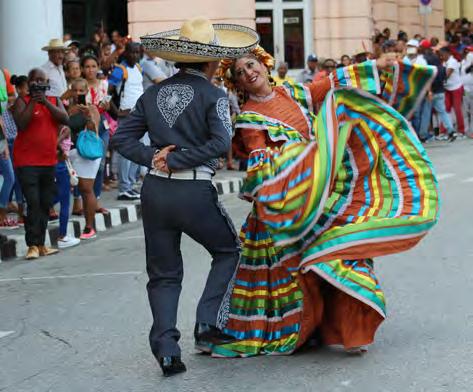

The First Taller Internacional de Industrias Culturales y Creativas fostered exchanges on topics such as the planning of strategies and policies for artistic and cultural creation that contribute to a more inclusive and sustainable city. Taller de Educadores Populares was also held, in which educators from different educational backgrounds met to discuss Cuban and Caribbean education. In addition, Taller de Arqueología del Caribe, from the University of Oriente, consisted of working tables, launch of archeological catalogs and panels, making an important contribution to the rescue of the history of these peoples. Taller de Religiosidad Popular brought together scholars on topics such as spiritualism, Regla del Palo, Vodú, OchaIfá, and people’s religiosity through songs, percussion and folkloric dance. Fruitful lectures, book launch events and project exhibitions were held in the Salón de los Grandes of the Casa de la Trova in Santiago.
Esperado por todos, el Desfile de la Serpiente, rítmico y multicolor, fue cita de la más auténtica diversidad cultural de la región. La entrega de la Mpaka – símbolo del Festival – al presidente de BioCubaFarma, Dr. C. Eduardo Martínez Díaz; la música de las Voces del Milagro y el Cabildo Cimarrón, Macubá, Los Ripiaos de Palma Soriano, los hombres carrozas y las estatuas vivientes, por solo citar algunos ejemplos, confluyeron en el encuentro. El gentío se congregó jubiloso en las aceras para disfrutar y saludar el legendario desfile. Durante la última jornada, se realizó la carga de la Mpaka, símbolo del festival, y las calles santiagueras se estremecieron con el Desfile del Fuego. A ritmo de conga, la ciudad celebró, entre disfraces, colores, bailes y comparsas, un hasta pronto a los participantes de diversas latitudes.
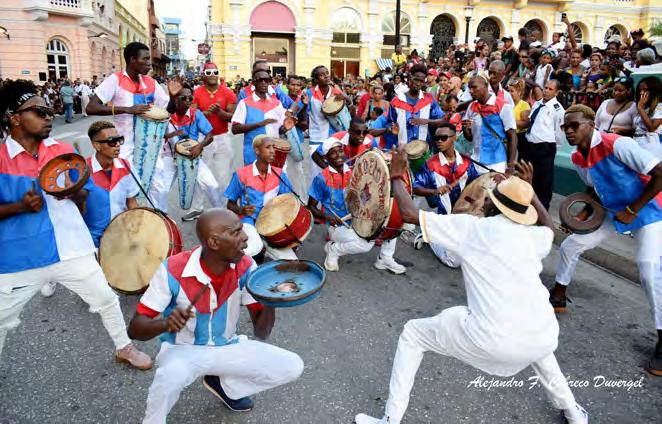
Desfile de la Serpiente, rhythmic and multicolored, was a meeting for the most authentic cultural diversity of the region, awaited by all. The presentation of the Mpaka, symbol of the Festival, to the president of BioCubaFarma, Dr.C. Eduardo Martínez Díaz, the music of Voces del Milagro and Cabildo Cimarrón, Macubá, Los Ripiaos de Palma Soriano, the float men and the living statues, just to mention a few examples, converged in the meeting. The crowd gathered jubilantly on the sidewalks to enjoy and greet the legendary parade. During the last day, the symbol of the Festival, Mpaka, was carried around and Desfile del Fuego shook the streets of Santiago. To the rhythm of the conga, the city celebrated with costumes, colors, dances and comparsas, a farewell to the participants from different latitudes.
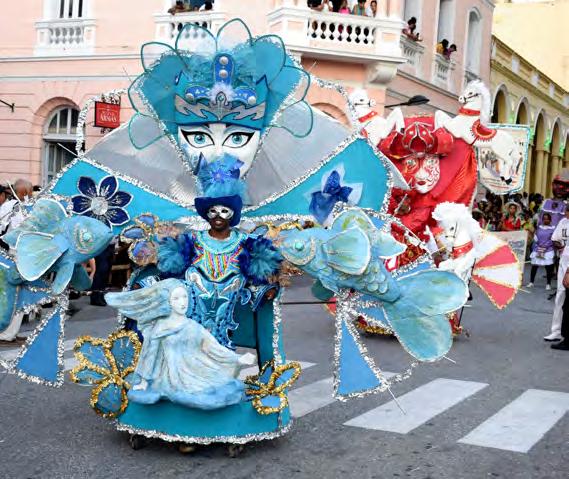


En la clausura, como es tradición, el pueblo santiaguero despidió el festival junto al mar, con la Quema del Diablo. Los vítores alejando el mal y abrazando buenos augurios inundaron el paseo marítimo La Alameda, mientras el icónico gran diablo ardía rodeado por la gran multitud. Concluyeron así los emocionantes días de la Fiesta del Fuego, con la presencia de delegaciones de más de una veintena de países, en la más caribeña de las ciudades cubanas. Festividad cumbre de la cultura popular y las tradiciones del Caribe, espacio para estrechar lazos y salvaguardar las raíces que nos unen. Desde la Casa del Caribe la invitación está hecha «¡Nos vemos en 2023!»
At the closing ceremony, as traditional, the people of Santiago bid farewell to the Festival by the sea, with Quema del Diablo. The cheers of the people of Santiago de Cuba, waving away evil and embracing good omens, flooded the promenade La Alameda, while the iconic big devil burned surrounded by the big crowd. The exciting days of the Fiesta del Fuego concluded with the presence of delegations from more than twenty countries in Santiago de Cuba. This is the peak festival of popular culture and traditions of the Caribbean, a space for strengthening ties and safeguarding the roots that unite us. From the Casa del Caribe the invitation is made “See you in 2023!”







